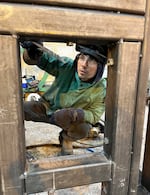
Desmond Hoy operates a stick welder at his job in North Portland on Oct. 22, 2024. Hoy credits WorkSource Oregon Reentry for helping him land this welding job.
Tiffany Camhi / OPB
Bright flashes of blue light illuminated Desmond Hoy’s welding mask, on a recent October morning. Gold sparks fell around Hoy’s feet as he carefully operated a stick welder to join two huge pieces of a metal rig.
“We’re building these big frames,” Hoy explained between welds. “I’m doing the overhead welds and just trying to make it level — flat.”
Hoy, 30, works the early shift at a fabrication shop in North Portland. This is his first full-time gig in a while, so he puts pressure on himself to do good work.
“It’s got to be all within spec,” Hoy said. “It’s got to look good.”
This job means a lot to Hoy because it took a lot of perseverance, determination and self-reflection for him to get to this stage in his life.
Five months ago, Hoy was incarcerated at Deer Ridge Correctional Institution in Madras, where he served more than three years for charges related to a car theft. Hoy spent most of his sentence working on himself. He earned his General Equivalency Diploma, became a tutor at the facility’s education center and learned a new trade: welding.
“I decided years ago that every decision I make is gonna be based on whether it strengthens my relationship with my loved ones,” Hoy said in April, when he was just weeks away from being released. “I got kids now. I’ve had time to get my priorities re-evaluated and I know that [welding] is something that I wanna get into as a career.”
Hoy credits WorkSource Oregon Reentry, a new employment program piloted at Deer Ridge, for building up his confidence and helping him achieve his goals both inside and outside of prison. He says the program helped him embark on a new future.
“They helped me recognize that I have the skills to pursue the career that I want,” Hoy said.

Desmond Hoy inspects and cleans up one of his welds on Oct. 22, 2024. Hoy credits WorkSource Oregon Reentry for helping him land this welding job.
Tiffany Camhi / OPB
The path to stability is rocky for many formerly incarcerated people. They must overcome social stigmas and barriers to housing, transportation and the workforce after returning to society. WorkSource Oregon Reentry looks to relieve the burden of one of those obstacles by bringing training and employment services directly to prisons, so people like Hoy can get a head start on the job hunt. Now the program is scaling up statewide, but its long-term sustainability is still in question.
A workforce plan that made sense
WorkSource Oregon, a partnership between state agencies and local nonprofits, is a key part of the state’s effort to get more Oregonians into well-paying jobs. At WorkSource offices throughout the state, anyone looking for work can get help with exploring new career options, whether that’s building a resume, writing cover letters or doing mock interviews. People can also get money to help pay for licenses and certifications and other no-cost job training resources.
The idea to house a center within a state prison came about in 2019 from East Cascade Works, a local workforce development board that serves 10 counties east of the Cascades. The board saw an untapped workforce opportunity right in front of their eyes: hundreds of people incarcerated at Deer Ridge and at Lake County’s Warner Creek Correctional Facility who would eventually be released.
These people, with the right resources and support, could potentially fill critical jobs in the state.
“It’s cultivating a talent pipeline that we need,” said Heather Ficht, executive director of East Cascades Works. “There’s 60,000 job openings right now in Oregon and we are not reproducing at a rate to replace the workforce.”
Related: New transfer degree gives Central Oregon prisoners a sense of hope
Oregon is currently in a severe workforce shortage, according to a state report released this year. For every 100 jobs posted in Oregon, there are just 66 people available to take them.
“We have historically low unemployment,” Ficht said. “So head, heart, bottom line: it made sense.”
Ficht’s organization partnered with the Oregon Employment Department and the Oregon Department of Corrections to develop a pilot program at Deer Ridge in 2022. The program started at Warner Creek a year later.
From idea to pilot
At Deer Ridge, WorkSource Reentry works hand-in-hand with prerelease programs already in place at the prison. Around three months before their release date, people held at the facility are offered a series of classes, like financial planning and stress management, to help them transition back to society.

Staff from WorkSource Oregon Reentry and Deer Ridge Correctional Institution help incarcerated people look for jobs and build employment profiles on April 30, 2024.
Tiffany Camhi / OPB
The services provided by WorkSource Reentry staff tie into an existing employment class and largely mirror the intensive case management provided outside of prison. But there are a few notable differences. For instance, the state’s prisons have strict rules about access to things like computers, printers and the internet — tools integral to finding jobs and filling out applications.
“Here, it’s like WorkSource in 1997,” said Andrew Larkin, employment specialist at OED and acting reentry coordinator at Deer Ridge. “We got hard copies. We can’t email PDFs. It’s a little bit like going into a time machine.”
During the pilot phase of the program, WorkSource Reentry staff had to figure out ways to work with the DOC’s technology limitations. Staff were eventually granted web access to iMatchSkills, a statewide employment database that pairs job seekers with employers.
But whether people at Deer Ridge compiled their work experience with pen and paper or electronically, the effect was still the same.
“After it was all down on paper, once I built my resume, it made my confidence go through the roof,” said Hoy, who started looking for Portland welding jobs through the WorkSource Reentry program this past spring, while he was still at Deer Ridge. “I was like, ‘I would hire me.’”

Desmond Hoy searches for entry-level welding jobs in the Portland area at Deer Ridge Correctional Institution on April 30, 2024.
Tiffany Camhi / OPB
Hoy is one of more than 200 formerly incarcerated people to go through the program at the facility since its launch. Over a third of that group have found steady employment or completed a job training program since being released.
Jobs to bring stability, reduce recidivism
A key goal of the program is to reduce the stress of job hunting for people leaving prison and entering the workforce.
Larkin said this population already has a lot to deal with right out of prison, like reconnecting with family, doing necessary paperwork like renewing licenses and meeting regularly with parole officers. That’s on top of becoming responsible again for meeting their own costly needs, such as housing, food and transportation.
“It’s a lot and can swallow you up when you first get out,” Larkin said. “Our mission is to remove one of the larger stressors so people know when it comes to this part, they’ve got a plan in place — they know who to talk to and they know where to go.”
Employment is also a requirement for DOC parolees.
Larkin said having a job helps bring much needed stability to people reentering society. Several studies have shown that formerly incarcerated people are less likely to reoffend if they are employed soon after being released from prison.
“These folks have a lot to offer and our communities will be stronger with these types of partnerships and opportunities for people,” said Larkin.
Expanding statewide

People nearing parole at Deer Ridge Correctional Institution receive job training services from WorkSource Oregon Reentry on April 30, 2024.
Tiffany Camhi / OPB
Two years after its launch and initial success, WorkSource Oregon Reentry is scaling up. Equity is a big reason for the expansion. DOC staff said it would like to offer this new employment resource to every person incarcerated at its 12 prisons across the state. The groundwork to build out that infrastructure is being laid now.
Ficht of East Cascade Works said the expansion will better serve people reentering society. That’s because most people are not released to the same location as the prison where they were held, a realization she had early on in the program.
“The bulk of returning citizens from both of the prisons in our area go to the Willamette Valley. They don’t stay here in Central Oregon,” Ficht said. “So we’re putting all this effort in to get people ready and we didn’t have a warm hand off for them in their home communities.”
In other words, there was a mismatch between support inside prison and what was available where former inmates wound up. But now the program has staff based in every region to connect with participants both before and after they are released from prison.
Related: Federal student aid arrives in time for fall classes at Central Oregon prison
WorkSource Reentry is also offering employment services at three more DOC correctional facilities, with plans to bring the program to the state’s seven other prisons by January 2025.
A mix of state and federal grants have buoyed the expansion of the program over the past three years, including two Workforce Ready grants totaling over $1 million. The state grants are a part of Future Ready Oregon, a $200 million investment in the state’s workforce from the Oregon Legislature in 2022. It also received a $3.8 million award from the U.S. Department of Labor in 2023.
But Ficht said the program cannot rely on grants to keep it running forever. She’s looking to the state legislature to step up.
“There has to be a sustainability plan in which the state of Oregon takes some responsibility for looking at the way they resource these kinds of services and programs,” said Ficht. “I truly believe that we will reduce recidivism and we’re gonna be able to show the cost savings of that by the time we run out of these funds.”
Ficht said the program will run out of grant funding in December 2026.
Building a career

Desmond Hoy walks back to his welding station after a lunch break on Oct. 22, 2024.
Tiffany Camhi / OPB
Hoy said his transition from Deer Ridge to Portland in June was not stress-free.
“I thought that the anxiety associated with getting released was just like a myth until it actually happened,” said Hoy. “I had panic attacks for days.”
But Hoy said the skills and confidence he gained from the WorkSource Reentry program helped anchor him. And both his new welding job and a recommitment to his family have helped bring a sense of purpose into his life. He’s grateful for the support he continues to receive from WorkSource programs.
“What they do helps out more people than they know,” Hoy said, during a lunch break at his new job. “What they’re doing is going to help me to provide for my family and instill all of the things [my family] needs in order to raise their own kids the right way.”
Hoy is excited for his future and he’s certain the path he’s going down will break the cycles of poverty from his past. And he has advice for other people on the verge of reentering society after incarceration:
“Work on your future — because what’s important is not where we’ve been, but where we’re going.”
This story was produced as part of the Higher Education Media Fellowship at the Institute for Citizens & Scholars. The Fellowship supports new reporting into issues related to postsecondary career and technical education.
